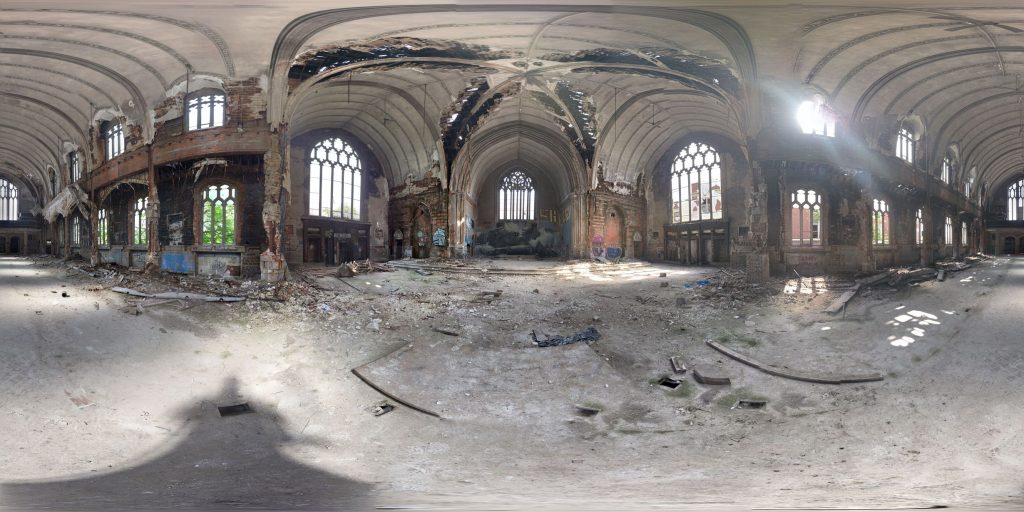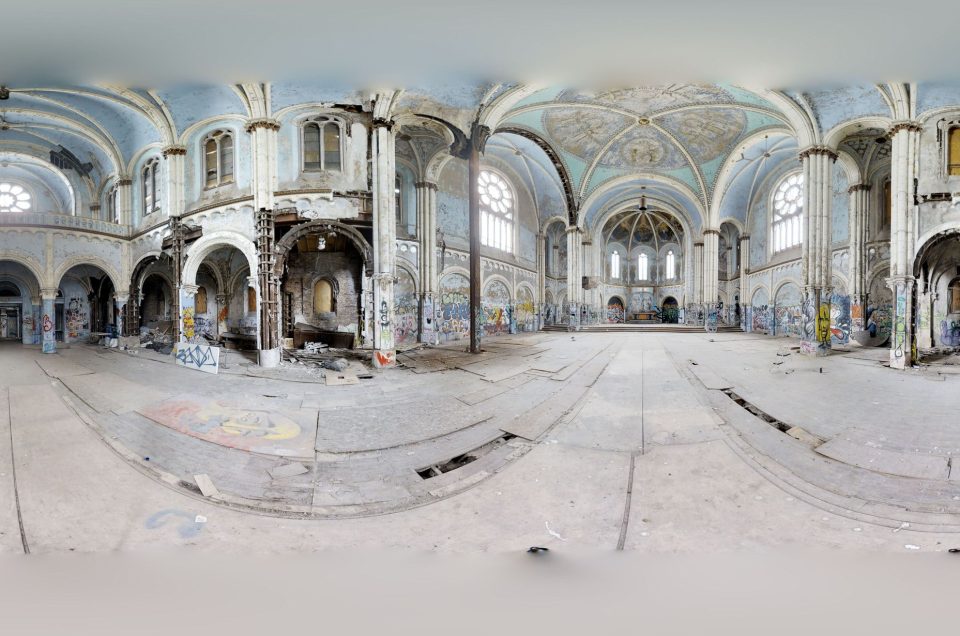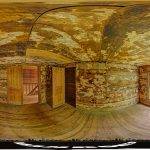St. Agnes Church and School
Embark on a comprehensive exploration of the abandoned St. Agnes Church and School, located in the heart of Detroit, Michigan. This journey involves more than a mere glance; it’s an immersive experience that demands a 360-degree perspective, encompassing every angle and aspect of these once-hallowed grounds. As you begin your circuitous observation, the architectural grandeur of the St. Agnes Church, despite its state of abandonment, commands attention. Notice the intricate details in the stonework, the towering spires that reach ambitiously towards the sky, and the stained-glass windows, now fractured but still hinting at their former splendor.
Continue your exploration towards the school, where hallways and classrooms once echoed with the sounds of learning and laughter, now silent and echoing a different story. Observe the overgrowth of nature as it reclaims the structures, with vines crawling up the walls and wildflowers peeking through the cracks in the pavement. This encroachment of nature paints a poignant picture of the passage of time and the impermanence of human endeavors. The entire scene is a tapestry of history, neglect, and the resilience of nature, telling a story that transcends the mere bricks and mortar of the buildings. As you complete your survey of the area, you’re left with a profound sense of the cycles of growth, decline, and the inevitable passage of time that characterizes the ever-changing landscape of a city like Detroit.
Image by: Albert Duce
Image by: Albert Duce
Introduction
Nestled in the heart of Detroit, Michigan, the St. Agnes Church and School stand as poignant symbols of faith, community resilience, and the ever-changing tides of urban life. This blog post delves into the rich history of St. Agnes Church and School, exploring its inception, its years of service to the community, and its current status, reflecting the broader narrative of Detroit’s own evolution.
Founding and Early Years
The story of St. Agnes Church and School began in April 1914 when a small congregation celebrated its first Mass in a modest frame house, a few blocks away from its future site in the LaSalle Park neighborhood. Rapid urban development, spurred by expanding streetcar lines and the advent of automobiles, led to the congregation quickly outgrowing its initial home. By 1916, a dedicated Catholic school was established, followed by a convent in 1917. The construction of the church, designed by the architectural firm Van Leyen, Schilling, Keough & Reynolds, commenced in 1922, with its cornerstone laid in a grand ceremony presided over by Bishop Michael J. Gallagher.
Architecture and Growth
St. Agnes Church officially opened its doors in November 1923 and was formally dedicated on June 1, 1924. The cost of construction was approximately $350,000, a testament to the generosity of its parishioners. The church’s design could accommodate 1,500 worshippers, reflecting the rapid growth of its congregation, which had reached 3,500 people within its first decade.
St. Agnes School
Adjacent to the church, St. Agnes School was a vital educational institution. Built in 1917, this red-brick, two-floor structure initially served students from grades one through twelve. Enrollment surged from 180 to over 800 students by the end of 1923. In 1958, the school transitioned to an all-girls institution, with enrollment stabilizing around 400 students. The school’s mascot, the “St. Agnes Panthers,” became a beloved symbol among its alumni.
Decline and Closure
The latter half of the 20th century saw significant changes in the LaSalle Park neighborhood and, consequently, St. Agnes Church and School. The 1967 Detroit riots marked a turning point, leading to a mass exodus of families and a steep decline in the congregation’s size. By 1989, the church, struggling with dwindling numbers, merged with St. Theresa Avila, forming the Martyrs of Uganda congregation. Despite these efforts, the school closed its doors in 2000, followed by the church in June 2006.
Mother Teresa’s Influence
A notable chapter in the church’s history was the establishment of a Missionaries of Charity convent by Mother Teresa in 1979. This was a significant event, symbolizing hope and service amidst the challenges faced by the community. However, even the presence of this renowned figure and her convent could not reverse the church’s declining fortunes.
Current Status
Today, the former St. Agnes School stands abandoned, a stark reminder of the area’s vibrant past and its challenges. The building has been subjected to extensive looting and vandalism, with most of its furnishings and fixtures removed. As of 2024, there are no plans for its redevelopment or demolition, leaving the structure in a state of neglect and disrepair.
Legacy and Reflection
The history of St. Agnes Church and School mirrors the broader narrative of Detroit – a city that has experienced significant growth, decline, and ongoing efforts at revitalization. From its early days as a bustling hub of Catholic worship and education, through periods of racial unrest and urban change, to its current status as a forgotten relic, St. Agnes serves as a poignant symbol of the city’s complex history.
The church and school’s impact on the community, however, endures in the memories of its former parishioners and students. The legacy of St. Agnes Church and School is not solely in its physical structure but in the lives it touched and the community it served. Its story is one of faith, resilience, and the enduring human spirit in the face of change and adversity.
Conclusion
St. Agnes Church and School in Detroit, Michigan, stand as historical landmarks that tell a story far greater than their physical presence. They embody the spirit of a community that thrived, faced challenges, and ultimately underwent transformation. As Detroit continues to evolve, the story of St. Agnes remains a vital chapter in understanding the city’s rich and complex history.
If you liked this post, you might like the Universal Healing Center and Chapel in Florida, the Wooden Church of St. Paraskevi in Russia or the Old Jones Gap Church in North Carolina.

A 360-degree panoramic image captured inside the abandoned St. Agnes Church and School in Detroit, Michigan. Image by: Albert Duce
Do you have 360-degree panoramic images captured in an abandoned location? Send your images to Abandonedin360@gmail.com. If you choose to go out and do some urban exploring in your town, here are some safety tips before you head out on your Urbex adventure.
Unlock the secrets of exploration by diving into precise GPS data available exclusively for an array of hidden gems and hundreds of other captivating sites, all within our members’ section. By investing in a Gold Membership, you’re not just gaining access; you’re securing a key to a vast, global archive of abandoned, untouched, and mysterious locations waiting to be discovered. Embark on your adventure with confidence, knowing every corner of the world can be within your reach. Don’t just observe—explore, discover, and claim the extraordinary journey that lies ahead with our treasure trove of world secrets. Subscribe now and transform the way you see the world! If you want to start shooting 360-degree panoramic images, you might want to look onto one-click 360-degree action cameras.
Click on a state below and explore the top abandoned places for urban exploring in that state.






